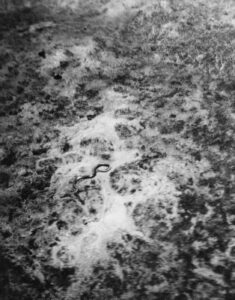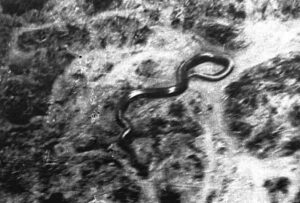Deep within the vast, untamed jungles of the Congo lies a story that has intrigued and mystified for decades: the legend of the Giant Congo Snake. Estimated to be up to 50 feet long, this massive serpent has captured the imaginations of many, spurring debates about its existence. Is it a modern cryptid, an undiscovered species, or simply a case of mistaken identity?
The Photograph That Sparked the Mystery
The legend gained international attention in 1959 when Belgian helicopter pilot Colonel Remy Van Lierde reportedly encountered a colossal snake during a mission over the Katanga region of the Democratic Republic of the Congo. Van Lierde claimed the snake was nearly 50 feet long and managed to capture a photograph from the air. The image, while compelling, is grainy and lacks clear points of reference, making it difficult to determine the snake’s true size. Critics argue that the photograph may exaggerate the snake’s size due to the angle, distance, or lack of scale. Supporters of the claim, however, believe the image shows a serpent of unprecedented size, possibly a new species or even a living relic of the prehistoric Titanoboa.

How Plausible Is a 50-Foot Snake?
In Africa, the largest known snake is the African rock python, which can grow up to 20 feet in exceptional cases. This falls far short of the alleged 50-foot length of the Giant Congo Snake. Meanwhile, the green anaconda of South America, known as the world’s heaviest snake, reaches lengths of around 27 feet. For comparison, the Titanoboa cerrejonensis, the largest snake in the fossil record, lived in South America around 60 million years ago. This prehistoric serpent was capable of growing up to 42-50 feet long and weighed an estimated 1.25 tons. Titanoboa thrived in a warm, humid environment with ample food, factors that would be necessary for any modern-day giant snake.



The Challenges of Life on Land
A snake of such immense size would face significant challenges, especially on land. Weighing over a ton, it would be slow and cumbersome, with its massive body struggling against gravity. Most likely, such a creature would be confined to aquatic environments, much like modern anacondas, which rely on water for support and mobility. The Congo basin, with its sprawling rivers, swamps, and dense rainforest, provides an ideal habitat for a creature of this magnitude. Reports suggest that the snake in Van Lierde’s photograph may have been spotted near a large water body, aligning with the theory that such creatures spend most of their time submerged and emerge only occasionally.


Leave a Reply